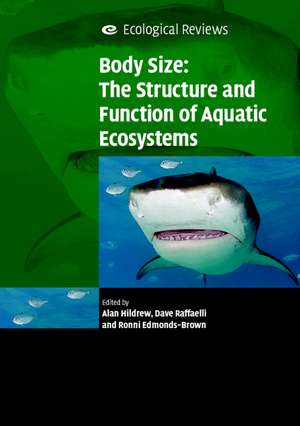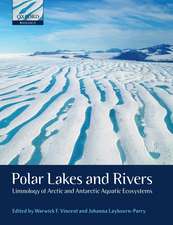Body Size: The Structure and Function of Aquatic Ecosystems: Ecological Reviews
Editat de Alan G. Hildrew, David G. Raffaelli, Ronni Edmonds-Brownen Limba Engleză Paperback – 11 iul 2007
Din seria Ecological Reviews
-
 Preț: 346.34 lei
Preț: 346.34 lei -
 Preț: 398.52 lei
Preț: 398.52 lei -
 Preț: 505.79 lei
Preț: 505.79 lei -
 Preț: 389.13 lei
Preț: 389.13 lei -
 Preț: 352.50 lei
Preț: 352.50 lei -
 Preț: 350.76 lei
Preț: 350.76 lei - 11%
 Preț: 483.89 lei
Preț: 483.89 lei - 14%
 Preț: 1244.07 lei
Preț: 1244.07 lei -
 Preț: 413.58 lei
Preț: 413.58 lei - 11%
 Preț: 471.60 lei
Preț: 471.60 lei -
 Preț: 363.07 lei
Preț: 363.07 lei -
 Preț: 363.13 lei
Preț: 363.13 lei - 14%
 Preț: 839.66 lei
Preț: 839.66 lei -
 Preț: 428.75 lei
Preț: 428.75 lei -
 Preț: 476.91 lei
Preț: 476.91 lei - 11%
 Preț: 441.20 lei
Preț: 441.20 lei - 11%
 Preț: 527.55 lei
Preț: 527.55 lei -
 Preț: 461.48 lei
Preț: 461.48 lei - 11%
 Preț: 625.04 lei
Preț: 625.04 lei -
 Preț: 399.77 lei
Preț: 399.77 lei -
 Preț: 337.46 lei
Preț: 337.46 lei
Preț: 427.68 lei
Preț vechi: 480.53 lei
-11% Nou
Puncte Express: 642
Preț estimativ în valută:
81.84€ • 85.66$ • 68.11£
81.84€ • 85.66$ • 68.11£
Carte tipărită la comandă
Livrare economică 31 martie-14 aprilie
Preluare comenzi: 021 569.72.76
Specificații
ISBN-13: 9780521679671
ISBN-10: 0521679672
Pagini: 356
Ilustrații: 102 b/w illus. 20 tables
Dimensiuni: 170 x 244 x 19 mm
Greutate: 0.71 kg
Editura: Cambridge University Press
Colecția Cambridge University Press
Seria Ecological Reviews
Locul publicării:Cambridge, United Kingdom
ISBN-10: 0521679672
Pagini: 356
Ilustrații: 102 b/w illus. 20 tables
Dimensiuni: 170 x 244 x 19 mm
Greutate: 0.71 kg
Editura: Cambridge University Press
Colecția Cambridge University Press
Seria Ecological Reviews
Locul publicării:Cambridge, United Kingdom
Cuprins
1. The metabolic theory of ecology and the role of body size in marine and freshwater ecosystems James H. Brown, Andrew P. Allen and James F. Gillooly; 2. Body size and suspension feeding Stuart Humphries; 3. Life histories and body size David Atkinson and Andrew G. Hirst; 4. Relationship between biomass turnover and body size for stream communities Alexander D. Huryn and Arthur C. Benke; 5. Body size in streams: macroinvertebrate community size composition along natural and human-induced environmental gradients Colin R. Townsend and Ross M. Thompson; 6. Body size and predatory interactions in fresh waters: scaling from individuals to communities Guy Woodward and Philip Warren; 7. Body size and trophic cascades in lakes J. Iwan Jones and Erik Jeppesen; 8. Body-size and scale-invariance: multifractals in invertebrate communities Peter E. Schmid and Jenny M. Schmid-Araya; 9. Body size and biogeography B. J. Finlay and G. F. Esteban; 10. By wind, wings or water: body size, dispersal and range size in aquatic invertebrates Simon D. Rundle, David T. Bilton and Andrew Foggo; 11. Body size and diversity in marine systems Richard M. Warwick; 12. Interplay between individual growth and population feed backs shapes body size distributions Lennart Persson and André M. De Roos; 13. The consequences of body-size in model microbial ecosystems Owen L. Petchey, Zachary T. Long and Peter J. Morin; 14. Body size, exploitation and conservation of marine organisms Simon Jennings and John D. Reynolds; 15. How body size mediates the role of animals in nutrient cycling in aquatic ecosystems Robert O. Hall, Jr., Benjamin J. Koch, Michael C. Marshall, Brad W. Taylor and Lusha M. Tronstad; 16. Body sizes in food chains of animal predators and parasites Joel E. Cohen; 17. Body size in aquatic ecology: important, but not the whole story Alan G. Hildrew, David G. Raffaelli and Ronni Edmonds-Brown.
Recenzii
'I can recommend this book to a wide audience. Not only students but experienced researchers also will find many stimulating chapters and a comprehensive list of the literature related to body size at the end of each chapter. The latter turns this book into an invaluable literature resource. …readers of this book will gain motivation to explore the importance and the limitations of body-size-related approaches to ecology in further studies.' Basic and Applied Ecology
'The metabolic theory of ecology (MTE) is a promising, upcoming conceptual framework which should be followed attentively in its future development and applications … this book will be interesting for anyone working with large databases and on the look for new applications and tests. Also, biology students wishing to be briefed on the state of the art of ecological analysis, will find this volume quite inspiring.' Zentralblatt für Geologie und Paläontologie
'The metabolic theory of ecology (MTE) is a promising, upcoming conceptual framework which should be followed attentively in its future development and applications … this book will be interesting for anyone working with large databases and on the look for new applications and tests. Also, biology students wishing to be briefed on the state of the art of ecological analysis, will find this volume quite inspiring.' Zentralblatt für Geologie und Paläontologie
Descriere
This 2007 book is an authoritative work written by leading experts unravelling the fundamental role of body size.






